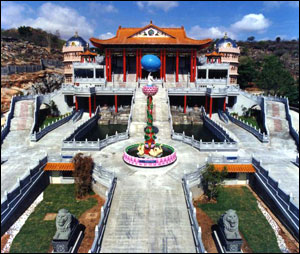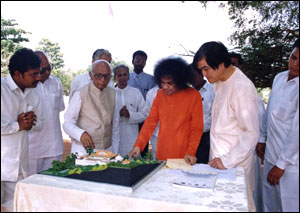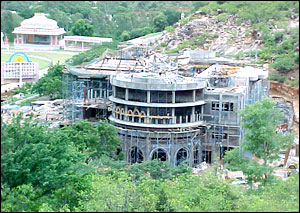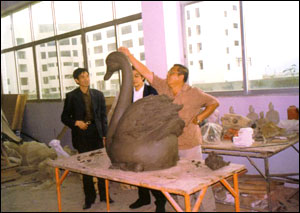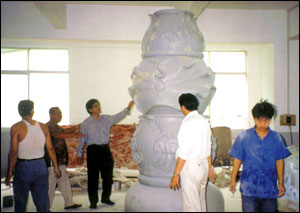 |
 |
 |
| Volume
3 - Issue 2, FEB 2005 |
THE MAKING OF CHAITANYA JYOTI [ This page has lots of Graphics. Allow time for the images to download. ] |
Devotees coming to Prashanti Nilayam always make it a point to visit the Chaintanya Jyoti Museum. Capturing devotees' hearts at first sight, Chaintanya Jyoti attracts all who view it to come closer and wonder at its sublime beauty. The building is like a gift-wrapped present from Swami to His devotees. One cannot resist the temptation to step inside and unwrap this wonderful gift of the Lord. Inside this magnificent gift are wonders to behold - breathtaking visual treats for the eye and entrancing music for the ears; wisdom for the mind and sustenance for the soul. Walking through the Museum is like walking with Swami at your side - nay inside. Many declare how the experience is ecstatic, transforming and moves them to tears. This second part of the Cover Story will introduce to you how this magnificent edifice came into being, the designs, the building process, the problems encountered and of course Swami's divine guidance and involvement, for it is He who inspired this living testament to the Divine. Genesis:
Various designs from all over the world were submitted to Swami at the time of Gurupoornima 1999. Swami chose the design that came from Malaysia and said that "It will be the wonder of the 21st century." The building proposed would be 75 feet high and form 8 levels. There was one year and 3 months to be ready for the Avatar's 75th Birthday, on 23rd November 2000, which was less than half the time estimated by the architect to complete the project.
Swami suggested
the auspicious date of 25th August 1999 for the Bhoomi Pooja
(ground breaking ceremony) and performed the ceremony even as the
architect finalized the drawings for the construction. The engineers
of ECC, a division of Larsen & Tourbro worked overtime to translate
the architectural drawings into those needed for construction at the
site. In the meantime, Swami selected a very experienced and dedicated
engineer, Col. S. K. Bose to look after the construction. Col. Bose
shifted his home from Delhi to Prashanti Nilayam in 10 days.
The first 13 containers that arrived at the Chennai Port were duly cleared and transported to the site without hassle. Somehow, this gave us assurance that we would not encounter any further problems, as the initial items were delivered to the site smoothly. However, this was not the case with the last nine containers, which coincidentally contained the major portion of the decorative components! Worst still, it was less than a month until the inauguration of the building. Somehow, the containers could not be located, despite repeated checks of the documents and verification of delivery by the dispatcher in China - the containers had seemingly disappeared. The team prayed for Baba's help. Miraculously, the containers were found and finally reached the work site on 6 November 2000, just 12 days before the inauguration date of 18 November 2000. The specialist and main contractors rushed to assemble the final items into place. Strangely, there was no panic on the ground. Everything fell into place and all the pieces fitted nicely without much hassle or changes. Everyone played his/her part perfectly.
Included
in the last 9 containers was the Stupa, which was a major item as
it was one of the focal points of the design concept. 36 feet tall,
the Stupa was imported in parts and made of a special material moulded
in sections; these parts were supposed to encase concrete columns
cast on site to combine as a single structure. However, the parts
arrived late due to the delay, and work started immediately as the
assembling of the Stupa involved several steps, all of which needed
sufficient time to complete. It was the 9th of November 2000. When the ordered crane finally arrived, another crisis occurred; the extension arm was not the right type! This was when things got a little frantic; the arm had to be extended, and extended fast. By then, it was the late afternoon of the 17th of November. Somehow, the modification was made possible by combining the booms of both of the cranes on site, using welding equipment belonging to the fencing contractor, who was also coincidentally on site. Apparently, all the tools we needed were on site to make the miraculous happen! The final placement of the lotus hand and the sphere took place at 9.45 PM, with concreting work still to be done. By the time the entire structure was assembled, it was just a few minutes before midnight. The concreting had only 8 hours to set fully before the inauguration took place at 8.00 am on 18 November 2000. Baba's Grace completed the Stupa just in the nick of time. The
Touch of the Divine
On one such occasion
five days before the inauguration, on the 13th November 2000, Swami
was entering the building when the glass front door shattered into
a myriad pieces. This was because of people pressing against it to
see Bhagavan. None were injured and Swami waited for the glass to
be cleared up before proceeding. This took a full five minutes, but
in the meantime Swami waited - the Embodiment of Patience and Tranquillity.
He then walked through as if nothing had happened. Of course, a new
door had to be ordered at breakneck speed to be ready for the opening
ceremony. Swami's
Visits after Inauguration Later, Bhagavan said in all graciousness "I did not have time to read everything. You need two days to see everything". The second time was on the first anniversary, 18th November 2001, when Swami blessed the staff who have the treasured role of maintaining the building and exhibits. The staff are after all most precious, for the Museum will last hundreds of years and millions will behold this testament to the Avatar. One of the building's purposes is to preserve for future generations the experience of the Divine Embodiment that the contemporaries of the Avatar are able to enjoy.
Conclusion Note: Heart to
Heart is planning to start a serial in the near future which will
take you through various sections of this wonderful museum. |
| Optimized for Netscape and Firefox. Best viewed in Internet Explorer - 1024 x 768 resolution. |
